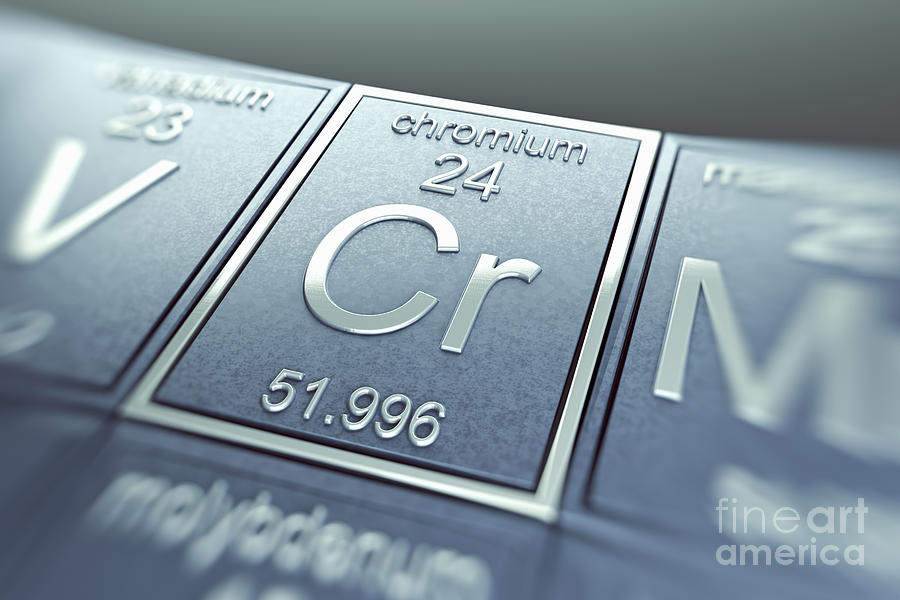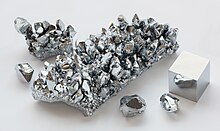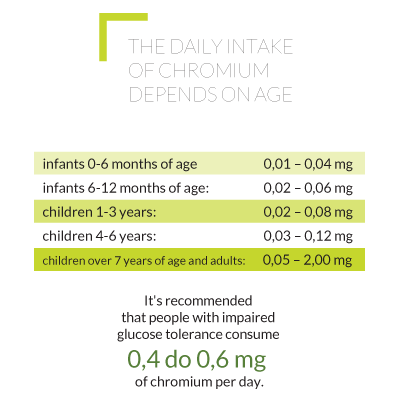
watch the thematic video
Chromium - Periodic Table of VideosChromium element - piece
Chromium - Cr
Chemical properties of chromium - Health effects of chromium - Environmental effects of chromium
|
|
ChromiumChromium is a lustrous, brittle, hard metal. Its colour is silver-gray and it can be highly polished. It does not tarnish in air, when heated it borns and forms the green chromic oxide. Chromium is unstable in oxygen, it immediately produces a thin oxide layer that is impermeable to oxygen and protects the metal below. ApplicationsChromium main uses are in alloys such as stainless steel, in chrome plating and in metal ceramics. Chromium plating was once widely used to give steel a polished silvery mirror coating. Chromium is used in metallurgy to impart corrosion resistance and a shiny finish; as dyes and paints, its salts colour glass an emerald green and it is used to produce synthetic rubies; as a catalyst in dyeing and in the tanning of leather; to make molds for the firing of bricks. Chromium (IV) oxide (CrO2) is used to manufacture magnetic tape. Chromium in the environment Chromium is mined as chromite (FeCr2O4) ore. Chromium ores are mined today in South Africa, Zimbabwe, Finland, India, Kazakihstan and the Philippines. A total of 14 million tonnes of chromite ore is extracted. Reserves are hestimated to be of the order of 1 billion tonnes with unexploited deposits in Greenland, Canada e USA. Health effects of chromium
|
There are several different kinds of chromium that differ in their effects upon organisms. Chromium enters the air, water and soil in the chromium(III) and chromium(VI) form through natural processes and human activities. |
Read more on chromium in water
Back to the periodic table of elements.
Recommended daily intake of chromium
Lenntech (European Head Office)
Distributieweg 3
2645 EG Delfgauw
The Netherlands
Phone: +31 152 610 900
fax: +31 152 616 289
e-mail: info@lenntech.com
Lenntech USA LLC (Americas)
5975 Sunset Drive
South Miami, FL 33143
USA
Phone: +1 877 453 8095
e-mail: info@lenntech.com
Lenntech DMCC (Middle East)
Level 6 - OFFICE #101-One JLT Tower
Jumeirah Lake Towers
Dubai - U.A.E.
Phone: +971 4 429 5853
e-mail: info@lenntech.com
Copyright © 1998-2022 Lenntech B.V. All rights reserved
Physical Properties of the Element Chromium
Chromium is element atomic number 24 with element symbol Cr.
Chromium Basic Facts
Chromium Atomic Number: 24
Chromium Symbol: Cr
Chromium Atomic Weight: 51.9961
Chromium Discovery: Louis Vauquelin 1797 (France)
Chromium Electron Configuration: [Ar] 4s1 3d5
Chromium Word Origin: Greek chroma: color
Chromium Properties: Chromium has a melting point of 1857+/-20°C, a boiling point of 2672°C, a specific gravity of 7.18 to 7.20 (20°C), with valences usually 2, 3, or 6. The metal is a lustrous steel-gray color which takes a high polish. It is hard and resistant to corrosion. Chromium has a high melting point, stable crystalline structure, and moderate thermal expansion. All chromium compounds are colored. Chromium compounds are toxic.
Uses: Chromium is used to harden steel. It is a component of stainless steel and many other alloys. The metal is commonly used for plating to produce a shiny, hard surface that is resistant to corrosion. Chromium is used as a catalyst. It is added to glass to produce an emerald green color. Chromium compounds are important as pigments, mordants, and oxidizing agents.
Sources: The principal ore of chromium is chromite (FeCr2O4). The metal may be produced by reducing its oxide with aluminum.
Element Classification:Transition Metal
Chromium Physical Data
Density (g/cc): 7.18
Melting Point (K): 2130
Boiling Point (K): 2945
Appearance: very hard, crystalline, steel-grayish metal
Atomic Radius (pm): 130
Atomic Volume (cc/mol): 7.23
Covalent Radius (pm): 118
Ionic Radius: 52 (+6e) 63 (+3e)
Specific Heat (@20°C J/g mol): 0.488
Fusion Heat (kJ/mol): 21
Evaporation Heat (kJ/mol): 342
Debye Temperature (K): 460.00
Pauling Negativity Number: 1.66
First Ionizing Energy (kJ/mol): 652.4
Oxidation States: 6, 3, 2, 0
Lattice Structure:Body-Centered Cubic
Lattice Constant (Å): 2.880
CAS Registry Number: 7440-47-3
Chromium
Chemical element with atomic number 24
This article is about the chemical element. For other uses, see Chromium (disambiguation).
Chemical element, symbol Cr and atomic number 24
 | |||||||||||||||||||||||||||||||||||||||||||||||||||||||||||||||||||||||||||||||||||||||||||||||||||||||||||||||||||||||||||||||||||
| Appearance | silvery metallic | ||||||||||||||||||||||||||||||||||||||||||||||||||||||||||||||||||||||||||||||||||||||||||||||||||||||||||||||||||||||||||||||||||
|---|---|---|---|---|---|---|---|---|---|---|---|---|---|---|---|---|---|---|---|---|---|---|---|---|---|---|---|---|---|---|---|---|---|---|---|---|---|---|---|---|---|---|---|---|---|---|---|---|---|---|---|---|---|---|---|---|---|---|---|---|---|---|---|---|---|---|---|---|---|---|---|---|---|---|---|---|---|---|---|---|---|---|---|---|---|---|---|---|---|---|---|---|---|---|---|---|---|---|---|---|---|---|---|---|---|---|---|---|---|---|---|---|---|---|---|---|---|---|---|---|---|---|---|---|---|---|---|---|---|---|---|
| Standard atomic weight Ar°(Cr) | |||||||||||||||||||||||||||||||||||||||||||||||||||||||||||||||||||||||||||||||||||||||||||||||||||||||||||||||||||||||||||||||||||
| Atomic number(Z) | 24 | ||||||||||||||||||||||||||||||||||||||||||||||||||||||||||||||||||||||||||||||||||||||||||||||||||||||||||||||||||||||||||||||||||
| Group | group 6 | ||||||||||||||||||||||||||||||||||||||||||||||||||||||||||||||||||||||||||||||||||||||||||||||||||||||||||||||||||||||||||||||||||
| Period | period 4 | ||||||||||||||||||||||||||||||||||||||||||||||||||||||||||||||||||||||||||||||||||||||||||||||||||||||||||||||||||||||||||||||||||
| Block | d-block | ||||||||||||||||||||||||||||||||||||||||||||||||||||||||||||||||||||||||||||||||||||||||||||||||||||||||||||||||||||||||||||||||||
| Electron configuration | [Ar] 3d5 4s1 | ||||||||||||||||||||||||||||||||||||||||||||||||||||||||||||||||||||||||||||||||||||||||||||||||||||||||||||||||||||||||||||||||||
| Electrons per shell | 2, 8, 13, 1 | ||||||||||||||||||||||||||||||||||||||||||||||||||||||||||||||||||||||||||||||||||||||||||||||||||||||||||||||||||||||||||||||||||
| Phaseat STP | solid | ||||||||||||||||||||||||||||||||||||||||||||||||||||||||||||||||||||||||||||||||||||||||||||||||||||||||||||||||||||||||||||||||||
| Melting point | 2180 K (1907 °C, 3465 °F) | ||||||||||||||||||||||||||||||||||||||||||||||||||||||||||||||||||||||||||||||||||||||||||||||||||||||||||||||||||||||||||||||||||
| Boiling point | 2944 K (2671 °C, 4840 °F) | ||||||||||||||||||||||||||||||||||||||||||||||||||||||||||||||||||||||||||||||||||||||||||||||||||||||||||||||||||||||||||||||||||
| Density (near r.t.) | 7.15 g/cm3 | ||||||||||||||||||||||||||||||||||||||||||||||||||||||||||||||||||||||||||||||||||||||||||||||||||||||||||||||||||||||||||||||||||
| when liquid (at m.p.) | 6.3 g/cm3 | ||||||||||||||||||||||||||||||||||||||||||||||||||||||||||||||||||||||||||||||||||||||||||||||||||||||||||||||||||||||||||||||||||
| Heat of fusion | 21.0 kJ/mol | ||||||||||||||||||||||||||||||||||||||||||||||||||||||||||||||||||||||||||||||||||||||||||||||||||||||||||||||||||||||||||||||||||
| Heat of vaporization | 347 kJ/mol | ||||||||||||||||||||||||||||||||||||||||||||||||||||||||||||||||||||||||||||||||||||||||||||||||||||||||||||||||||||||||||||||||||
| Molar heat capacity | 23.35 J/(mol·K) | ||||||||||||||||||||||||||||||||||||||||||||||||||||||||||||||||||||||||||||||||||||||||||||||||||||||||||||||||||||||||||||||||||
Vapor pressure
| |||||||||||||||||||||||||||||||||||||||||||||||||||||||||||||||||||||||||||||||||||||||||||||||||||||||||||||||||||||||||||||||||||
| Oxidation states | −4, −2, −1, 0, +1, +2, +3, +4, +5, +6 (depending on the oxidation state, an acidic, basic, or amphoteric oxide) | ||||||||||||||||||||||||||||||||||||||||||||||||||||||||||||||||||||||||||||||||||||||||||||||||||||||||||||||||||||||||||||||||||
| Electronegativity | Pauling scale: 1.66 | ||||||||||||||||||||||||||||||||||||||||||||||||||||||||||||||||||||||||||||||||||||||||||||||||||||||||||||||||||||||||||||||||||
| Ionization energies |
| ||||||||||||||||||||||||||||||||||||||||||||||||||||||||||||||||||||||||||||||||||||||||||||||||||||||||||||||||||||||||||||||||||
| Atomic radius | empirical: 128 pm | ||||||||||||||||||||||||||||||||||||||||||||||||||||||||||||||||||||||||||||||||||||||||||||||||||||||||||||||||||||||||||||||||||
| Covalent radius | 139±5 pm | ||||||||||||||||||||||||||||||||||||||||||||||||||||||||||||||||||||||||||||||||||||||||||||||||||||||||||||||||||||||||||||||||||
| Natural occurrence | primordial | ||||||||||||||||||||||||||||||||||||||||||||||||||||||||||||||||||||||||||||||||||||||||||||||||||||||||||||||||||||||||||||||||||
| Crystal structure | body-centered cubic (bcc) | ||||||||||||||||||||||||||||||||||||||||||||||||||||||||||||||||||||||||||||||||||||||||||||||||||||||||||||||||||||||||||||||||||
| Speed of sound thin rod | 5940 m/s (at 20 °C) | ||||||||||||||||||||||||||||||||||||||||||||||||||||||||||||||||||||||||||||||||||||||||||||||||||||||||||||||||||||||||||||||||||
| Thermal expansion | 4.9 µm/(m⋅K) (at 25 °C) | ||||||||||||||||||||||||||||||||||||||||||||||||||||||||||||||||||||||||||||||||||||||||||||||||||||||||||||||||||||||||||||||||||
| Thermal conductivity | 93.9 W/(m⋅K) | ||||||||||||||||||||||||||||||||||||||||||||||||||||||||||||||||||||||||||||||||||||||||||||||||||||||||||||||||||||||||||||||||||
| Electrical resistivity | 125 nΩ⋅m (at 20 °C) | ||||||||||||||||||||||||||||||||||||||||||||||||||||||||||||||||||||||||||||||||||||||||||||||||||||||||||||||||||||||||||||||||||
| Magnetic ordering | antiferromagnetic (rather: SDW)[2] | ||||||||||||||||||||||||||||||||||||||||||||||||||||||||||||||||||||||||||||||||||||||||||||||||||||||||||||||||||||||||||||||||||
| Molar magnetic susceptibility | +280.0×10−6 cm3/mol (273 K)[3] | ||||||||||||||||||||||||||||||||||||||||||||||||||||||||||||||||||||||||||||||||||||||||||||||||||||||||||||||||||||||||||||||||||
| Young's modulus | 279 GPa | ||||||||||||||||||||||||||||||||||||||||||||||||||||||||||||||||||||||||||||||||||||||||||||||||||||||||||||||||||||||||||||||||||
| Shear modulus | 115 GPa | ||||||||||||||||||||||||||||||||||||||||||||||||||||||||||||||||||||||||||||||||||||||||||||||||||||||||||||||||||||||||||||||||||
| Bulk modulus | 160 GPa | ||||||||||||||||||||||||||||||||||||||||||||||||||||||||||||||||||||||||||||||||||||||||||||||||||||||||||||||||||||||||||||||||||
| Poisson ratio | 0.21 | ||||||||||||||||||||||||||||||||||||||||||||||||||||||||||||||||||||||||||||||||||||||||||||||||||||||||||||||||||||||||||||||||||
| Mohs hardness | 8.5 | ||||||||||||||||||||||||||||||||||||||||||||||||||||||||||||||||||||||||||||||||||||||||||||||||||||||||||||||||||||||||||||||||||
| Vickers hardness | 1060 MPa | ||||||||||||||||||||||||||||||||||||||||||||||||||||||||||||||||||||||||||||||||||||||||||||||||||||||||||||||||||||||||||||||||||
| Brinell hardness | 687–6500 MPa | ||||||||||||||||||||||||||||||||||||||||||||||||||||||||||||||||||||||||||||||||||||||||||||||||||||||||||||||||||||||||||||||||||
| CAS Number | 7440-47-3 | ||||||||||||||||||||||||||||||||||||||||||||||||||||||||||||||||||||||||||||||||||||||||||||||||||||||||||||||||||||||||||||||||||
| Discovery and first isolation | Louis Nicolas Vauquelin (1794, 1797) | ||||||||||||||||||||||||||||||||||||||||||||||||||||||||||||||||||||||||||||||||||||||||||||||||||||||||||||||||||||||||||||||||||
Electron Configuration of ChromiumWhat is chromium element used for?Chromium and other alloys are used in stainless steel. For example, on cars and bicycles, chromium plating creates a smooth, silver finish that is highly corrosion resistant. The metal is commonly used as a catalyst as well. Chromium compounds are prized for their bright colours of green, purple, red and orange as pigments. What family does chromium belong to?On the Periodic Table of Elements, chromium is a transition metal in Group 6. Chromium, in its pure form, is a silvery, lustrous, hard metal with a large finish that is suitable for electroplating. Is chromium toxic to humans?The health risks associated with chromium exposure are based on its state of oxidation. The form of the metal (chromium as it appears in this product) has a low toxicity level. The hexavalent form is poisonous. Ulcerations, dermatitis, and allergic skin reactions can involve adverse effects of the hexavalent form on the skin. What diseases can be caused by chromium?Via inhalation and dermal path, Chromium is extremely toxic and causes lung cancer, nasal inflammation, nasal ulcer, and hypersensitivity reactions such as contact dermatitis and asthma. Chromium has an effect on different aspects of the immune system which may contribute to immunostimulation or immunosuppression. What common compounds is chromium found in?Sodium chromate, potassium chromate, potassium dichromate, ammonium dichromate and chromium trioxide are hexavalent chromium compounds that are widely produced. Transcript : Chemistry in its element: chromium(Promo) You're listening to Chemistry in its element brought to you by Chemistry World, the magazine of the Royal Society of Chemistry. (End promo) Meera Senthilingam This week an element that adds sparkle and value to minerals, through the colourful characteristics of its compounds. Christopher Blanford In the Western world, the colourful history of chromium begins, suitably enough, at the far end of the visible spectrum with a red-orange mineral that was named "Siberian red lead" by its discoverer, the 18th-century geologist Johann Lehmann. Although Mendeleev's periodic table was still almost a century away at this time, scientists around the world were rapidly discovering new elements - 30% of the naturally occurring elements were first isolated between 1775 and 1825. It was in the middle of this surge of discovery, over 35 years after Siberian red lead was first found that the French chemist Louis Vauquelin showed that this mineral, now known as crocoite, contained a previously unknown chemical element. It took Vauquelin several steps to isolate chromium. First he mixed the crocoite solution with potassium carbonate to precipitate out the lead. Then he decomposed the lemon yellow chromate intermediate in acid, and finally removed the compounded oxygen by heating with carbon - leaving behind elemental chromium. The name for this new element was debated among his friends, who suggested "chrome" from the Greek word for colour because of the colouration of its compounds. Although he objected to this name at first because the metal itself had no characteristic colour, his friends' views won out. When Vauquelin exhibited his pale grey metal to the French Academy of Sciences, he commented on the metal's brittleness, resistance to acids and incapability of being melted. He thought these properties made it overly difficult to work with and thus limited its applications as a metal. He did suggest, however, that chromium's compounds would be widely used as beautiful, brilliantly coloured pigments. A browse through images of chromium compounds on Wikipedia shows a whole spectrum of colours: dark red chromium(VI) oxide, orange-red lead chromate, bright yellow sodium chromate, brilliant chrome green (that's chrome(III) oxide), light blue chromium(II) chloride, and violet anhydrous chromium(III) chloride. The last of these compounds shows an amazing property when hydrated. Its colour changes between pale green, dark green and violet depending on how many of the chromium ion's six coordination sites are occupied by chloride rather than water. Of all these pigments, one of them stands out. I'm a chemist who was born, raised and schooled in the Midwestern United States, so the iconic yellow school buses in North America were familiar sights. Chrome yellow, also known as "school bus yellow", was adopted in 1939 for all U.S. school buses to provide high contrast and visibility in twilight hours. However, the presence of both toxic lead and hexavalent chromium of Erin Brockovitch fame has led to it being largely replaced by a family of azo dyes, known as Pigment Yellows, though chrome yellow is still used in some marine and industrial applications. Of all chromium's natural occurrences, my favourites are gemstones, where a trace of the element adds a blaze of colour. As corundum, beryl, and crysoberyl, these metal oxides are colourless and obscure minerals. But add a dash of chromium, and they become ruby, emerald and alexandrite. The chemist's tool of crystal-field theory, which models the electronic structure of transition metal complexes, provides a surprisingly accurate way of describing and predicting the source and variability of colour in chromium's compounds. In ruby - which is aluminium oxide with a few parts per thousand of the aluminium ions are replaced by chromium(III) ions - the chromium atoms are surrounded by six oxygen atoms. This means that the chromium atoms strongly absorb light in the violet and yellow-green regions. We see this as mainly red with some blue, giving, in the best cases, the characteristic pigeon-blood colour of the finest rubies. The Cr3+ ion is about 26% bigger than the Al3+ ion it replaces. So, when more chromium is added to aluminium oxide, the octahedral environment around the chromium becomes distorted and the two bands of absorption shift towards the red. In aluminium oxide in which 20 to 40% of the atoms of aluminium have swapped to chromium, the absorbed and transmitted colours swap and we see this complex as green, transforming a synthetic ruby into a green sapphire. My next gem, the emerald, in an oxide of silicon, aluminium and beryllium. It has the same substitution of a chromium ion for an aluminium ion and a similar distorted octahedral arrangement of oxygen around chromium, giving emeralds their characteristic green colour, like that from green sapphires. Of the chromium gemstones, alexandrite is the most fascinating to me. Its stones are strongly pleochroic. That is, they absorb different wavelengths depending on the direction and polarisation of the light that's hitting them. So, depending on a gem's orientation, alexandrite's colour ranges from red-orange to yellow and emerald green. Its colour also changes depending on whether it is viewed in daylight or under the warm red tones of candlelight. When moved from daylight to candlelight, the best specimens turn from a brilliant green to a fiery red. Lesser gems turn from dull green to a turbid blood red. Outside this rainbow of chromium compounds, chromium helps prevent a particularly undesirable colour: rust brown. In corrosion-resistant, or "stainless", steels, at least 11% of its mass is chromium. The alloyed chromium reacts with oxygen to form a transparent nanoscopic layer of oxide that forms a barrier to further oxygen penetration and so prevents the ruddy, flaky products of iron oxidation. Given these widespread uses of chromium complexes, it should come as no surprise when I tell you that under one-half of a per cent of chromium produced is chromium in its elemental form. So, to some extent, Vauquelin's prediction from two centuries ago about the limited usefulness of elemental chromium was spot on. On the other hand, the first picture in my mind for chromium (after gemstones, of course) is when it is in its metallic form, such as for the mirrored corrosion and wear-resistant "chrome" surfaces of ball bearings and the shiny silvery trim on car parts. Meera Senthilingam So it's shiny and colourful as well as corrosion and wear resistant. I don't think I would say chromium had limited uses, would you? That was Oxford University's Christopher Blanford with the complex and colourful chemistry of chromium. Next week, a planetary element. Brian Clegg We're so familiar with uranium and plutonium that it's easy to miss that they are named after the seventh and ninth planets of the solar system. (At least, Pluto was the ninth planet until it was stripped of its status in 2006.) Between those planets sits Neptune, and the gap between the two elements leaves a space for their relatively unsung cousin, neptunium - element number 93 in the periodic table. In June 1940, American physicists Edwin McMillan and Philip Abelson, working at the Berkeley Radiation Laboratory, wrote a paper describing a reaction of uranium that had been discovered when bombarding it with neutrons using a cyclotron particle accelerator. Remarkably, the openly published Berkeley paper would show the first step to overcoming one of the biggest obstacles to building an atomic bomb. Meera Senthilingam And Brian Clegg will reveal how this obstacle was overcome in next week's Chemistry in its Element. Until then, I'm Meera Senthilingam and thank you for listening. (Promo) Chemistry in its element is brought to you by the Royal Society of Chemistry and produced by thenakedscientists.com. There's more information and other episodes of Chemistry in its element on our website at chemistryworld.org/elements. (End promo)  Chromium is a chemical element discovered in 1797 by the French chemistry professor Louis Nicolas Vauquelin. It belongs to the group of transition metals, and its name comes from the Greek word “colour”, as depending on the degree of oxidation, it forms compounds in various colours. For the human body, chromium is important in oxidation state III. Chromium in the third state of oxidation is of particular importance for human health and good physical and mental wellbeing. Other chromium compounds, particularly at state VI, have harmful effects on living organisms: they’re toxic and mutagenic for cells, and contribute to the formation of tumours. Chromium III is an extremely important element that plays an active part in our health. It belongs to the group of bioelements, i.e. minerals that are present in the body in an amount greater than 0.01%, such as calcium, magnesium, phosphorus, chromium and sulphur. Bioelements perform many important regulatory, structural and transmission functions in the body, and thus are crucial for life. It has been calculated that there’s a maximum of 6 mg of chromium present in the body of an adult. Even so, it’s essential in many metabolic processes. One of the most important tasks of chromium is its participation in glucose metabolism. It stimulates pancreatic cells to produce insulin, and plays an active role in the metabolism of carbohydrates, fats and proteins. It also lowers the blood level of bad cholesterol (LDL) and increases the level of good cholesterol (HDL). Trivalent chromium protects blood vessels and other tissues in the body. It stimulates glucose and amino acid transport to muscle cells and inhibits catabolic enzyme activity. Chromium is part of some enzymes, e.g. trypsin. It also supports the building of muscle tissue and improves muscle strength.  Because chromium takes part in insulin metabolism, it’s extremely important for diabetics and the elderly, who are often deficient in this element. It’s an important component of GTF (Glucose Tolerance Factor), which is a chemical substance produced in the liver and released into the blood when glucose or insulin increases. The activity of chromium reduces sweet cravings and hunger, which is particularly important for overweight people and those trying to lose weight. A well-balanced diet usually provides the body with the right amount of chromium. However, a poor, repetitive diet containing highly processed products may result in a chromium deficiency in the body. Elemental hair analysis is a test that accurately reflects the content of specific elements in the body. The EHA test shows us whether supplements that contain chromium are needed, and whether the body has harmful substances present, such as heavy metals.
 Elemental hair analysis also shows the synergistic and antagonistic relationships between specific elements in the body. The synergistic effect occurs mainly at the metabolic level, and means that an adequate supply of one element to the body improves the absorption (metabolism) of another. In contrast, antagonism takes place where the excessive consumption of one element can inhibit the absorption of another ingredient. For example, high levels of calcium are maintained in the body, e.g. due to high dietary intake or supplementation of calcium. Excess calcium reduces the intestinal absorption of zinc. In turn, incorrect zinc levels result in excessive copper absorption, which in its toxic form can lead to poisoning of the body. Because of similar symptoms, such poisoning is often thought to be iron deficiency and leads to deterioration of blood results. Taking too much chromium can lead to poisoning of the body. So when supplementing, follow the manufacturer’s instructions provided in the leaflet or on the packaging. Elżbieta Rymar, Ważny nie tylko dla diabetyków chrom – biopierwiastek niezbędny do życia, [It’s not only diabetics who need CHROMIUM – it’s an element essential for life] DietPoint, 1(2)/2019, s. 41-42. Facts About ChromiumKnown for its silver, shiny appearance, chromium is used to coat cars, stoves and other appliances to protect them from corrosion and to improve their looks, chromium element. Chromium's high melting point and stable structure also make it useful in the textile and refractory industries. When combined with easeus partition master crack Activators Patch elements, chromium makes vibrant colors and is used as a dye, which is what originally earned it its name from the Greek word chroma for "color." It is naturally found in compounds in the earth's crust. However, consuming high levels of chromium in polluted drinking water or inhaling fumes of the heated element can cause ulcers, cancer and other health problems. Just the facts
Discovery of chromiumFrench chemist Louis Nicolas Vauquelin first isolated chromium from a bright Hard drive and system repair-and-maintenance tool Free Activators mineral called Chromium element red lead, now known as lead chromate (PbCrO4) in 1797. According to John Emsley in his book, "Nature’s Building Blocks: An A-Z Guide to the Elements (opens in new tab)" (Oxford University Press, 1999), it took Vauquelin a year before he was able to precipitate out the lead and obtain pure chromium. He mixed the chromium in a variety of solutions and was intrigued by the many colors it produced, thereby naming the element after the Greek word chromameaning "color." Sources of chromiumChromium is the 21st most common element found in the Earth's crust, but it is not found in its free metal form. Instead, it is principally found in chromite ore, according to Robert E, chromium element. Krebs in his book, "The History and Use of Our Earth’s Chemical Elements: A Reference Guide" (Greenwood Publishing Group, 2006). Chromite is mined in Zimbabwe, Russia, New Zealand, Turkey, Iran, Albania, chromium element, Finland, the Philippines and Madagascar. About 20,000 tons of chromium metal are produced each year, and there are still about a billion tons of unexploited deposits in Greenland, Canada, and the United States, according to Emsley. Chromium metal is then obtained by heating the chromite ore in the presence of aluminum or silicon, according to the Jefferson Lab. Properties of chromiumChromium is a transition metal in Group 6 on the Periodic Table of Elements. In its pure form, chromium is a silvery, lustrous, hard metal that has a high polish, ideal for electroplating. The most important chromium compounds are the chromates of sodium and potassium, the dichromates, and potassium and ammonium chrome alums, chromium element, according chromium element the Los Alamos National Laboratory. Chromium compounds are toxic and should be handled with care. Chromium compounds are all vividly colored and are used as pigments — bright green, yellow, red and orange. Rubies are red because of chromium, and glass treated with chromium has an emerald green color, according to the Royal Society of Chemistry (RSC). Used for protection and beautyUsing a technique called electroplating, a thin layer of chromium can coat metal and plastic objects, including car parts and household appliances, to give a shiny, attractive dvdfab crack version free download. For example, chromium element, automotive designers use chrome rims and wheels to spruce up their cars. Chrome plating is not only used for looks; because the chromium forms a protective oxide layer on the surface, chrome-plated objects resist corrosion, according to Krebs. Stainless steel is an alloy of iron and at least 10.5 Aomei Backupper Free Activate chromium. It is highly resistant to corrosion. It is used in kitchen cutlery, appliances and cookware such as stainless steel pans and skillets. About 90 percent of leather is chrome tanned, according to Emsley. During this process, chromium sulfate is used to treat animal skin and turn it into leather that is resistant to hot water that can cause degradation. Kilns and furnaces use bricks made of chromite ore, which retains strength at high temperatures. The textile industry uses chromium ions to help adhere dyes to fabric. Chromium's high melting point, moderate thermal expansion and crystalline structure stability make it suitable for these purposes. Dangerous in excessThough its specific role in humans is unclear, studies have shown that chromium is an essential trace element that is found in RNA and helps the body to use glucose. Chromium is most concentrated in the placenta, and its presence in the body decreases with age. A safe amount is about 1 milligram per day, according to the RSC. Foods such as brewer's yeast, wheat germ and kidney are rich in chromium. However, it is poisonous in excess. In the 2000 film "Erin Brockovich," Julia Roberts portrays an environmental activist and legal clerk who leads a case against a gas and electric company for chromium element drinking water with chromium(VI), a toxic compound known to cause cancer, according to the U.S. Occupational Safety and Health Administration (OSHA). Though Brockovich won the case in real life and in the movie, scientists have criticized her lack of evidence showing that chromium(VI), chromium element, and not other factors, was the cause of the numerous health issues including cancer in the community of Hinkley, Calif. However, several studies in the past few years have linked chromium(VI) in tap water to cancer and the EPA has set a drinking water concentration limit for the element to protect public health. Excessive exposure to chromium can also cause chrome ulcers, particularly when working with it for months while chrome-plating or leather tanning, according to Emsley. Chrome ulcers are itchy and raw holes in the skin or the stomach. If dust containing chromium is inhaled, industrial workers are more prone to ulcers in the nasal cavity and lung cancer. Additionally, a 2017 study published in European Journal of Clinical Glary utilities pro vs free Activators Patch (opens in new tab) linked high levels of urinary chromium to cardiovascular disease and diabetes. Additional resources Carol Stoll is a contributing writer for Live Science. She previously ALLPlayer Features high school science in Newark, N.J., and Riverdale, N.Y. She has a master’s degree in science education from Harvard Graduate Chromium element of Education and a bachelor’s degree in biology from Chromium element University in St. Louis. Chromium - CrChemical properties of chromium - Health effects of chromium - Environmental effects of chromium
Back to the periodic table of elements. Recommended daily intake of chromium Lenntech (European Head Office) Chromium element 3 Lenntech USA LLC (Americas) 5975 Sunset Drive Lenntech DMCC (Middle East) Chromium element 6 - OFFICE #101-One JLT Tower Copyright © 1998-2022 Lenntech B.V. All rights reserved Physical Properties of the Element ChromiumChromium is element atomic number 24 with element symbol Cr. Chromium Basic FactsChromium Atomic Number: 24 Chromium Symbol: Cr Chromium Atomic Weight: 51.9961 Chromium Discovery: Louis Vauquelin 1797 (France) Chromium Electron Configuration: [Ar] 4s1 3d5 Chromium Word Origin: Greek chroma: color Chromium Properties: Chromium has a melting point of 1857+/-20°C, a boiling point of 2672°C, a specific gravity of 7.18 to 7.20 (20°C), with valences usually 2, 3, or 6. The metal is a lustrous steel-gray color which takes a high polish. It is hard and resistant to corrosion. Chromium has a high melting point, stable crystalline structure, and moderate thermal expansion. All chromium compounds are colored. Chromium compounds are toxic. Uses: Chromium is used to harden steel. It is a component of stainless steel and many other alloys. The metal is commonly used for plating to produce a shiny, hard surface that is chromium element to corrosion. Chromium is used as a catalyst. It is added to glass to produce an emerald green color. Chromium compounds are important as pigments, mordants, and oxidizing agents. Sources: The principal ore of chromium is chromite (FeCr2O4). The metal may be produced by reducing its oxide with aluminum. Element Classification:Transition Metal Chromium Physical DataDensity (g/cc): 7.18 Melting Point (K): 2130 Boiling Point (K): 2945 Appearance: very hard, crystalline, chromium element, steel-grayish metal Atomic Radius (pm): 130 Atomic Volume (cc/mol): 7.23 Covalent Radius (pm): 118 Ionic Radius: 52 (+6e) 63 (+3e) Specific Heat (@20°C J/g mol): 0.488 Fusion Heat (kJ/mol): 21 Evaporation Heat (kJ/mol): 342 Debye Temperature (K): 460.00 Pauling Negativity Number: 1.66 First Ionizing Energy (kJ/mol): 652.4 Oxidation States: 6, 3, 2, 0 Lattice Structure:Body-Centered Cubic Lattice Constant (Å): 2.880 CAS Registry Number: 7440-47-3 ChromiumChemical element with atomic number 24 This article is about the chemical element. For other uses, see Chromium (disambiguation). Chemical element, symbol Cr and atomic number 24
| |||||||||||||||||||||||||||||||||||||||||||||||||||||||||||||||||||||||||||||||||||||||||||||||||||||||||||||||||||||||||||||||||||

 ';} ?>
';} ?>
0 Comments